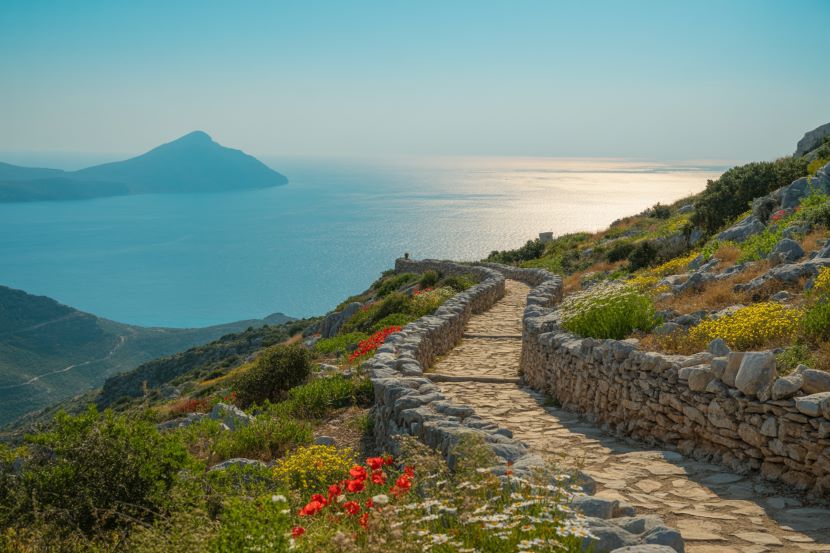Published on
August 17, 2025

Step onto the Lycian Way and you’re stepping into an epic story that unfolds along four hundred and seventy-two miles of Turquoise coast. Starting in Fethiye and running south to Antalya, the path weaves between crumbling temples, empty hilltop villages, and wildflower-strewn valleys, inviting today’s trekkers to keep pace with the Lycians of an earlier age. Every bend in the trail reveals another chapter, and you’ll soon be flanked by the weathered marble of a Byzantine theater, the haunting silhouettes of Kayaköy’s abandoned cottages, and silk-blue coves that seem like postcards torn from a dream. Over the course of the trek, more than twenty-five major archaeological sites dot the route, each a gateway into the past, each a reminder that you’re walking more than a scenic path; you’re walking history itself.
The Trail and Its Historic Significance
The Lycian Way is one of the world’s most iconic long-distance hikes, weaving through Turkey’s southwestern region of Lycia. Opened in 1999, the official path spans 760 kilometers (472 miles) and offers hikers the opportunity to explore a region steeped in ancient history. This area was once home to the Lycian people, who established one of the Mediterranean’s most advanced and mysterious civilizations.
The trek offers stunning views of the turquoise Mediterranean Sea and takes hikers through diverse landscapes, from rugged hillsides to olive groves. Along the way, you’ll encounter numerous ancient tombs carved into rock faces, Roman ruins, and Byzantine monasteries, each telling stories of civilizations that have shaped the region over millennia.
Kayaköy: The Abandoned Ghost Town
One of the most haunting and remarkable sights along the Lycian Way is the ghost town of Kayaköy. Perched on a hillside not far from the ruins of the Lycian city of Karmylassos, Kayaköy remains an open-air museum. The village, which once housed a thriving Greek community, was abandoned in the early 1920s as part of a population exchange agreement following the Greco-Turkish War. Today, its preserved homes and churches stand as silent witnesses to this tumultuous period in history.
Hikers passing through this eerie town are left in awe of its well-preserved architecture and the stories it holds within its crumbling walls. The deserted streets are eerily quiet, making it an ideal spot for reflection and connection to the past. The sight of 500 homes and three churches, all still intact, paints a vivid picture of what life in Kayaköy was like before it became a ghost town.
Historic Sites Along the Way
Aside from Kayaköy, the Lycian Way passes several other important ancient sites, making it a true cultural and historical treasure trove. The trail weaves near ancient Lycian cities such as Olympos, Patara, and Myra. In Myra, for instance, visitors can marvel at rock tombs and the well-preserved theater, where performances once entertained the Lycian elite.
The ruins at Patara are particularly notable for their spectacular amphitheater and grandiose city gates. Meanwhile, Olympos is famous for its ancient ruins scattered throughout the valley, set against the backdrop of the Mediterranean Sea. Each of these locations offers hikers the chance to step back in time and imagine life in one of the most influential civilizations of the ancient world.
Best Time to Visit
While the Lycian Way can be trekked year-round, the most favorable seasons are spring (March–June) and autumn (September–November). During these months, the weather is mild, making the hike more enjoyable. Summer temperatures along the trail can reach scorching highs, which might make it difficult for some hikers to navigate the rugged path comfortably.
It’s recommended to plan your trip in advance, especially if you intend to hike the entire 472 miles. The trail is well-marked with red and white markers, and a good map and camping gear will be essential if you plan to camp along the route. Many hikers prefer to tackle shorter sections of the Lycian Way, given its length and challenging terrain.
The Hiking Experience: What to Expect
Hiking the Lycian Way is not only a journey through history but also an immersive adventure through Turkey’s diverse landscapes. The trail offers spectacular views of the Mediterranean, including pristine beaches, pine forests, and steep cliffs. Walkers can expect to see wildlife, including various bird species, and the occasional olive tree grove, a staple of the Mediterranean countryside.
As you pass through villages along the way, you’ll also have the opportunity to experience the region’s rich culture. Traditional Turkish hospitality is part of the journey, as locals offer food and rest for weary hikers. Whether you choose to hike independently or with a guide, the experience is unforgettable.
Why the Lycian Way is a Must-Do for Hikers and History Lovers
The Lycian Way offers an unparalleled combination of scenic beauty, ancient history, and cultural significance. It’s more than just a trail, it’s a window into the ancient world, where ruins and ghost towns hold the secrets of the past. For hikers and history enthusiasts alike, it’s an opportunity to walk through the pages of history while surrounded by some of the world’s most stunning natural beauty.
A Walk Through Time
If you want a hike that mixes adventure with a taste of the past, the Lycian Way should be at the top of your list. You’ll wander from the quiet, abandoned lanes of Kayaköy to the stunning rock tombs at Myra, moving through Turkey’s history step by step. All the while, the calm waves of the Mediterranean keep you company. Whether you’re a well-traveled backpacker or someone who loves old stories, the Lycian Way gifts you memories that stay with you long after the trail ends.







